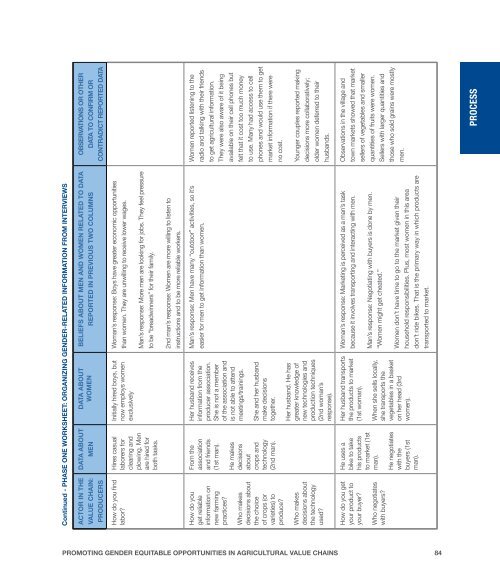promoting gender equitable opportunities in agricultural ... - weman
promoting gender equitable opportunities in agricultural ... - weman
promoting gender equitable opportunities in agricultural ... - weman
You also want an ePaper? Increase the reach of your titles
YUMPU automatically turns print PDFs into web optimized ePapers that Google loves.
Cont<strong>in</strong>ued - PHASE ONE WORKSHEET: ORGANIZING GENDER-RELATED INFORMATION FROM INTERVIEWSACTOR IN THEVALUE CHAIN:PRODUCERSDATA ABOUTMENDATA ABOUTWOMENBELIEFS ABOUT MEN AND WOMEN RELATED TO DATAREPORTED IN PREVIOUS TWO COLUMNSHow do you f<strong>in</strong>dlabor?Hires casuallaborers forclear<strong>in</strong>g andplow<strong>in</strong>g. Menare hired forboth tasks.Initially hired boys, butnow employs womenexclusivelyWoman’s response: Boys have greater economic <strong>opportunities</strong>than women. They are unwill<strong>in</strong>g to receive lower wages.Man’s response: More men are look<strong>in</strong>g for jobs. They feel pressureto be “breadw<strong>in</strong>ners” for their family.2nd man’s response: Women are more will<strong>in</strong>g to listen to<strong>in</strong>structions and to be more reliable workers.How do youget reliable<strong>in</strong>formation onnew farm<strong>in</strong>gpractices?Who makesdecisions aboutthe choiceof crops (orvarieties) toproduce?Who makesdecisions aboutthe technologyused?From theassociationand friends(1st man).He makesdecisionsaboutcrops andtechnology(2nd man).Her husband receives<strong>in</strong>formation from theproducer association.She is not a memberof the association andis not able to attendmeet<strong>in</strong>gs/tra<strong>in</strong><strong>in</strong>gs.She and her husbandmake decisionstogether.Her husband. He hasgreater knowledge ofnew technologies andproduction techniques(2nd woman’sresponse).Man’s response: Men have many “outdoor” activities, so it’seasier for men to get <strong>in</strong>formation than women.How do you getyour product toyour buyer?Who negotiateswith buyers?He uses abike to takehis productsto market (1stman).He negotiateswith thebuyers (1stman).Her husband transportsthe products to market(1st woman).When she sells locally,she transports thevegetables <strong>in</strong> a basketon her head (3rdwomen).Woman’s response: Market<strong>in</strong>g is perceived as a man’s taskbecause it <strong>in</strong>volves transport<strong>in</strong>g and <strong>in</strong>teract<strong>in</strong>g with men.Man’s response: Negotiat<strong>in</strong>g with buyers is done by men.“Women might get cheated.”Women don’t have time to go to the market given theirhousehold responsibilities. Plus, most women <strong>in</strong> this areadon’t ride bikes. That is the primary way <strong>in</strong> which products aretransported to market.OBSERVATIONS OR OTHERDATA TO CONFIRM ORCONTRADICT REPORTED DATAWomen reported listen<strong>in</strong>g to theradio and talk<strong>in</strong>g with their friendsto get <strong>agricultural</strong> <strong>in</strong>formation.They were also aware of it be<strong>in</strong>gavailable on their cell phones butfelt that it cost too much moneyto use. Many had access to cellphones and would use them to getmarket <strong>in</strong>formation if there wereno cost.Younger couples reported mak<strong>in</strong>gdecisions more collaboratively;older women deferred to theirhusbands.Observations <strong>in</strong> the village andtown markets showed that marketsellers of vegetables and smallerquantities of fruits were women.Sellers with larger quantities andthose who sold gra<strong>in</strong>s were mostlymen.ProcessPROMOTING GENDER EQUITABLE OPPORTUNITIES IN AGRICULTURAL VALUE CHAINS 84










